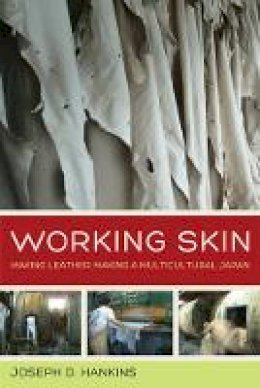
Stock image for illustration purposes only - book cover, edition or condition may vary.
Working Skin: Making Leather, Making a Multicultural Japan
Joseph D. Hankins
€ 41.70
FREE Delivery in Ireland
Description for Working Skin: Making Leather, Making a Multicultural Japan
Paperback. Since the 1980s, arguments for a multicultural Japan have gained considerable currency against an entrenched myth of national homogeneity. This book enters this conversation with an ethnography of Japan's Buraku" people. Series: Asia Pacific Modern. Num Pages: 304 pages, 15 b/w photos. BIC Classification: 1FPJ; JFSC; JHMC. Category: (G) General (US: Trade). Dimension: 151 x 230 x 18. Weight in Grams: 428.
Since the 1980s, arguments for a multicultural Japan have gained considerable currency against an entrenched myth of national homogeneity. Working Skin enters this conversation with an ethnography of Japan's Buraku people. Touted as Japan's largest minority, the Buraku are stigmatized because of associations with labor considered unclean, such as leather and meat production. That labor, however, is vanishing from Japan: Liberalized markets have sent these jobs overseas, and changes in family and residential record-keeping have made it harder to track connections to these industries. Multiculturalism, as a project of managing difference, comes into ascendancy and relief just as the labor it struggles to represent is disappearing. Working Skin develops this argument by exploring the interconnected work of tanners in Japan, Buraku rights activists and their South Asian allies, as well as cattle ranchers in West Texas, United Nations officials, and international NGO advocates. Moving deftly across these engagements, Joseph Hankins analyzes the global political and economic demands of the labor of multiculturalism. Written in accessible prose, this book speaks to larger theoretical debates in critical anthropology, Asian and cultural studies, and examinations of liberalism and empire, and it will appeal to audiences interested in social movements, stigmatization, and the overlapping circulation of language, politics, and capital.
Product Details
Publisher
University of California Press
Format
Paperback
Publication date
2014
Series
Asia Pacific Modern
Condition
New
Number of Pages
304
Place of Publication
Berkerley, United States
ISBN
9780520283299
SKU
V9780520283299
Shipping Time
Usually ships in 7 to 11 working days
Ref
99-1
About Joseph D. Hankins
Joseph D. Hankins researches the politics and productivity of labor. He is Assistant Professor of Anthropology at UC San Diego and is affiliated with the UCSD Critical Gender Studies Program and the UC Center for New Racial Studies. He was raised in Lubbock, Texas, one source of the rawhide processed in Japanese tanneries.
Reviews for Working Skin: Making Leather, Making a Multicultural Japan
Finely composed and researched.
Stephen Mansfield Japan Times Gutsy... [Hankins] took tremendous pains to put himself at the heart of the Buraku community and expose himself to the widest possible range of experiences... Well-observed. Social Science Japan Journal Hankins has written a fascinating ethnography that examines the complexities and contradictions inherent in the labor of multiculturalism. American Anthropologist Working Skin is a highly original treatise... offers powerful insights... The book sets a new gold standard. Pacific Affairs Book Review [Working Skin] makes a significant contribution to a new generation of scholarship on buraku issues. Journal of Japanese Studies
Stephen Mansfield Japan Times Gutsy... [Hankins] took tremendous pains to put himself at the heart of the Buraku community and expose himself to the widest possible range of experiences... Well-observed. Social Science Japan Journal Hankins has written a fascinating ethnography that examines the complexities and contradictions inherent in the labor of multiculturalism. American Anthropologist Working Skin is a highly original treatise... offers powerful insights... The book sets a new gold standard. Pacific Affairs Book Review [Working Skin] makes a significant contribution to a new generation of scholarship on buraku issues. Journal of Japanese Studies
